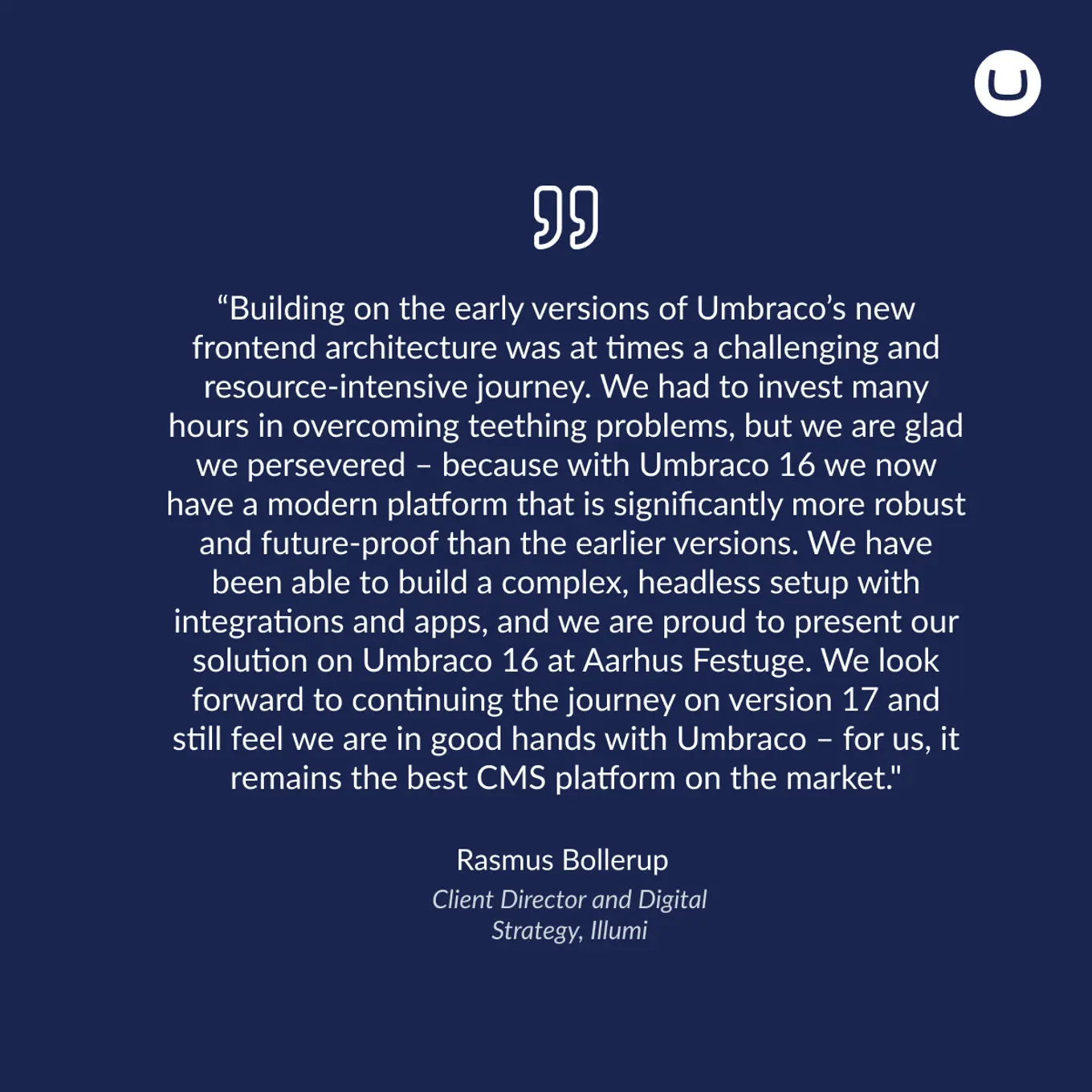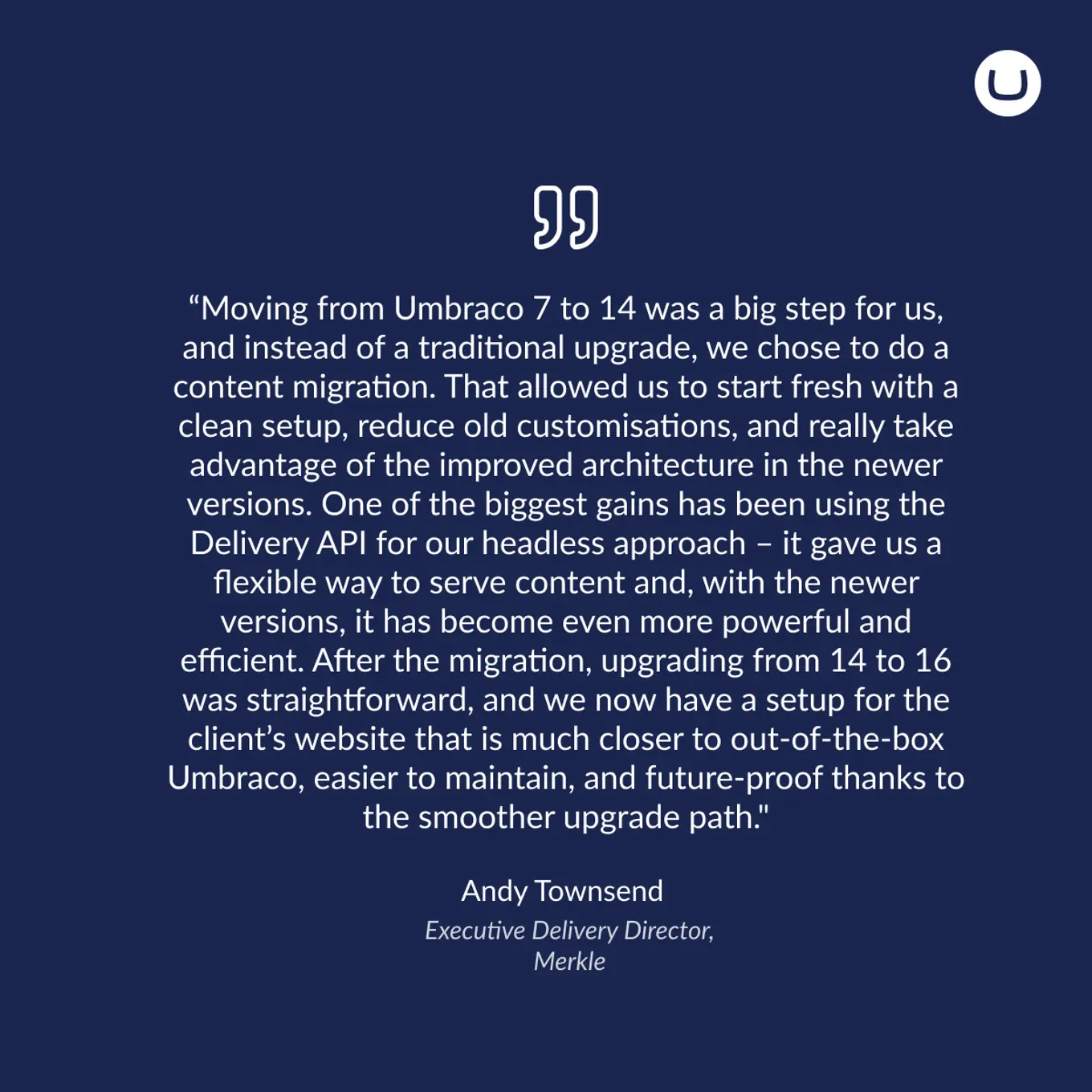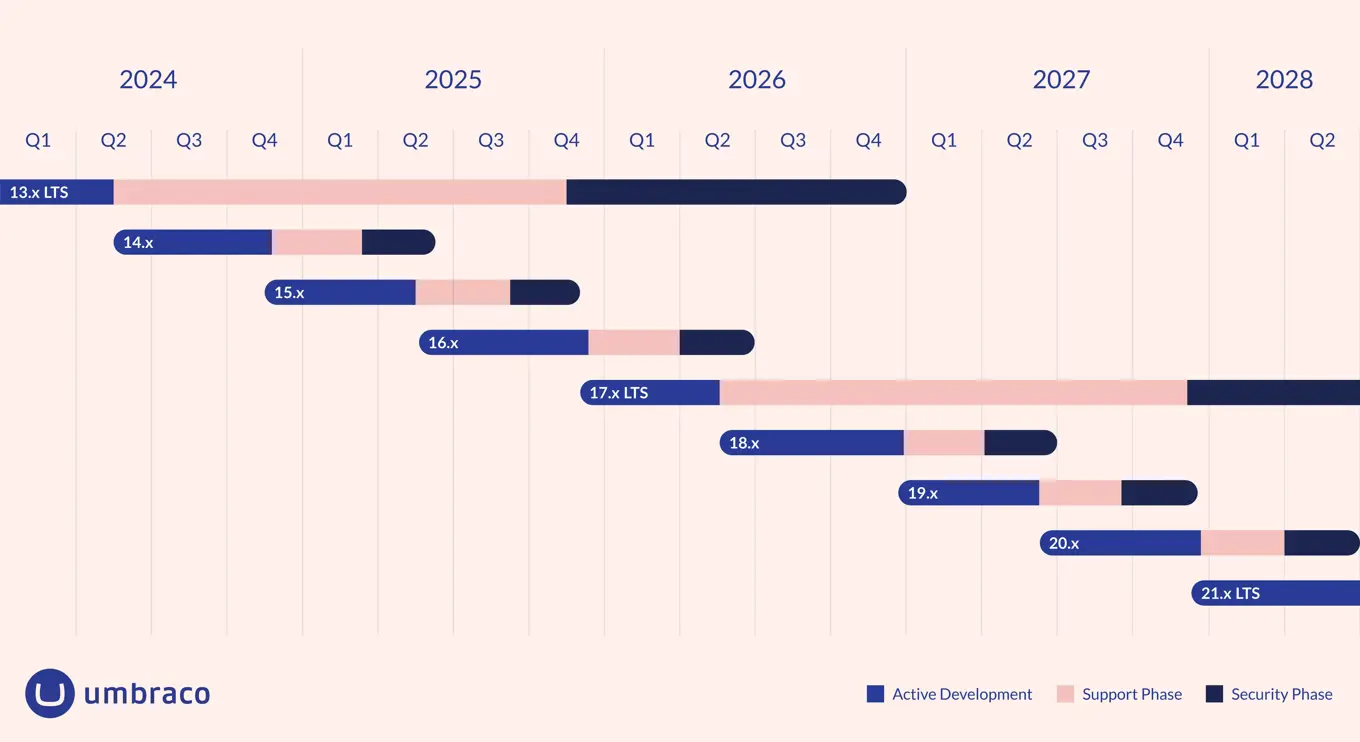
Umbraco 17: Ready, Reliable, and Less Scary than It Sounds

Why introduce a beta?
We’ve adjusted the naming of our pre-release stages to better reflect what each one represents. In previous release cycles, there were sometimes last-minute updates going into what we called a Release Candidate, which didn't feel aligned with the naming and raised questions about the stability of the Release Candidate. By calling this stage a Beta instead, we’re being clearer: this is when final adjustments may still happen. This stage is for our product team and package developers to have an early look at the release and start their work to be ready by launch. By the time the Release Candidate (RC) is out — about four weeks before the final release — we aim for stability, with only minimal changes expected. That’s where your feedback really matters, helping us ensure a smooth and reliable final release.
In short:
- Beta (now): Feature development is considered complete. Changes will be limited to bug fixes and issue resolution.
- Release Candidate: Changes will occur only to resolve regression issues identified in version 17 (since the previous minor of 16). This is where your testing feedback is crucial.
- Final Release: Stable, market-tested, and production-ready.
Install the beta from NuGet
GitHub release notes

We can’t fix what we don’t know
… and we really want to - so we need your help!
The superpower of Umbraco is that we are open-source. We strongly rely and depend on our ecosystem testing each of our releases. Every bug you catch, every edge case you uncover, helps us make the final release stronger.
How you can help:
-
Report issues in the CMS issue tracker
- Indicate in the title which version of the beta or release candidate you found an issue in, e.g., 17.0.0-beta. For an example, please see this
-
Share a copy of your project - it can save hours of debugging and speed up fixes. We’ll handle it with care and confidentiality.
That’s everything you need to know about the Beta and RC process. Thanks to your feedback, Umbraco 17 will be stronger and more stable for everyone.
Now, let’s take a step back and look at what makes Umbraco 17 such an important release.
Your Friendly Overview
Umbraco 17 is more than just the next version - it’s the next big milestone. As the new Long-Term Supported (LTS) release, many of you will be upgrading directly from Umbraco 13. That’s a big leap, and it’s worth taking stock of what’s changed along the way.
Since Umbraco 14, we’ve introduced a brand-new backoffice architecture (known as the Bellissima Project). For some, that shift has been exciting; for others, it’s raised questions about how to adapt extensions and new APIs. Both reactions are valid. Big changes come with both opportunities and challenges.
But here’s the good news: by the time you land on Umbraco 17, you’re not stepping into something experimental - you’re stepping into a mature, modern, and stable platform that has been stress-tested and polished with each release.

This quote captures the journey well: the early bumps are behind us, and the foundation is now strong.
The elephant in the backoffice
There is no doubt that the Bellissima Project is the elephant in the backoffice. It introduced a brand-new frontend architecture, which means your custom extensions built for the Umbraco 13 backoffice need to be reworked with modern tools (Web Components), new methods, and perhaps the Management API.
Since the first release in June 2024, we’ve worked closely with partners and the Umbraco community to ensure that everything you knew and loved from Umbraco 13 is also in 17 - polished, improved, and built on a strong foundation. Retired methods for extending the backoffice now have alternatives, and we worked hard to make sure those alternatives support your real-world use cases.
Extension as first-class citizens
There’s still a decent amount of work to be done if you have customizations in your backoffice project. And let’s be honest - Umbraco is the most extendable CMS out there, so of course you’ve built epic extensions that scratch your editor's itch and set your project aside from the rest.
Rebuilding those extensions for the new backoffice frontend architecture might feel frustrating, tedious, and like a waste of money at first glance. Here’s what it really brings: a modern platform (no longer tied to the discontinued AngularJS framework), with even more extension options than before (thanks to an extension-first architecture), and - most importantly - the reassurance that your extensions aren’t just clever hacks in the backoffice. They are treated as first-class citizens that we actively want to cater to when building new features, and protect when we make updates.
As one of our partners recently put it: “I can’t know what the client will request in the future, but I’m convinced that Umbraco can be extended to match it.”. That’s exactly why extensibility is so important - and why we take responsibility for making sure your customizations remain supported.
Key benefits of Umbraco 17
And this is where the big picture comes in. Umbraco is growing, and more and more businesses rely on Umbraco as a critical part of their digital setup. An extensible CMS is unique for Umbraco, and we take the responsibility for supporting your extensions in the best possible way. That’s why these changes matter: they ensure the unique aspects of your Umbraco project are secure, robust, and future-proof.
On top of that, you also get:
-
Modern, future-proof technology: Bellisima is built with Web Components and TypeScript, giving you a stable foundation that avoids the pitfalls of outdated frameworks (like AngularJS end-of-life). No more dependency worries — just a solid, maintainable base.
-
Reduces technical debt: AngularJS is gone, and the new structure gives you a cleaner, more predictable way forward. Plus, the developer experience also improves, with better tooling like IntelliSense and smoother IDE integration.
-
Lower long-term costs: Yes, upgrades like this do take effort now, but the whole point is to save time and money: less patching, less firefighting, and fewer surprises.
-
UI framework flexibility: Your project is no longer tied to Angular - teams can choose the framework that best fits their needs (Vue, React, Svelte, Preact, Solid.js, etc.)
-
Talent attraction and retention: Modern platforms attract modern developers. With Umbraco running on the latest .NET and supporting any frontend framework, your projects stay appealing to the people who build them.
Upgrading from Umbraco 13 to 17: What to Expect
The good news: Umbraco 17 has all the features you loved in Umbraco 13. Everything you’re used to is still there, often improved to make life easier for developers and editors.
Video: Starting with Umbraco 16.4, document states are now indicated by symbols next to the document icon. Users can hover over these symbols to view the current state. Umbraco includes core entity signs such as Unpublished Changes, Scheduled Publishing, and Protected. As always, you can extend this functionality and add your own entity signs.
But features out of the box are only half the story. The bigger part is the variety of methods you rely on to extend the backoffice. We are aware that some of these methods are being retired, and that change can be frustrating. If you’ve built extensions around these, it means rethinking, re-developing, and learning new approaches. That’s real effort, and we don’t want to gloss over that challenge.
Breaking Changes with Built-In Alternatives
Take SendingContentNotification as an example. Over time, it’s also been stretched into all sorts of clever workarounds - ways of working with content that we couldn’t always anticipate. And that unpredictability makes it fragile: every time we update or add new features, your implementation risks breaking. To address this, we’ve divided SendingContentNotification into more structured and predictable features based on the most common use cases you shared with us.
This way, the functionality you depend on remains available and compatible between releases, and supported by design.
As has happened before, the Umbraco community was ahead of us. Our partner Kraftværk built a package for a specific scenario where SendingContentNotification was often used: filtering available blocks based on user, content type, or other custom logic. Find it here Kraftvaerk Umbraco Block Filter.
And we’re working to make the transition as smooth as possible, through updated documentation and open communication on GitHub about what’s changing and why - because we know this isn’t just a technical decision, it impacts your business and your clients.
You’ll find resources designed to spark ideas and give you practical examples for rebuilding or migrating your extensions:
-
Examples and Playground - frontend examples of backoffice elements, that you can try out locally in your project
- Codegarden 2025: Next-level Backoffice
-
Explore how Umbraco HQ uses Bellissima in Umbraco Workflow 16 (static asset repo)
Yes, there is an upfront investment. But the goal is a more predictable, modern foundation and more peace of mind that your work won’t be undone.
So, how big is the upgrade going to be then?
The honest answer: it depends on your project and what version you're upgrading from.
Here are our estimations:
If you’re on Umbraco 15 or 16, the upgrade is straightforward. Going from Umbraco 13 to 17 is an LTS-to-LTS upgrade, so it’s more than just a regular upgrade (hello, breaking changes of Umbraco 14), but it’s not a start-from-scratch rebuild either. So, before you worry, here’s a breakdown of what to consider to help you scope the upgrade and understand why it's manageable rather than overwhelming. You can also read more about general upgrade guidance here.
-
The database and schema migrations are usually automatic and handled by Umbraco when version 17 starts up. If you’ve a large site, allow extra time for migrations to run, always back up, and validate the migrations if you have big content sets.
-
For features/APIs being deprecated: yes, change always stings a little. But we have a good overview of breaking changes for each major version in the Umbraco documentation, with alternatives explained.
-
Custom extensions of the backoffice are the most significant variable going from Umbraco 13 to 17: the more custom extensions you’ve got, the more rebuilding and testing will be involved.
-
Third-party packages: ensure that all packages used in your Umbraco project are compatible with the latest version of Umbraco. Most package maintainers keep up with LTS releases, but it’s worth verifying on Umbraco Marketplace before you upgrade.
Version-by-Version Highlights
The road from Umbraco 13 to 17 includes big milestones. Here is your overview and links to read more, so make yourself a cuppa and start updating yourself on the latest changes in Umbraco.
Umbraco 14
The most impactful update involved replacing AngularJS with Web Components and introducing the Management API, for the backoffice to communicate with the backend. This is where most of the custom extension rework happens. Read all about the changes in Umbraco 14 here:
Breaking changes in Umbraco 14
Umbraco 14 Release Candidate blog post
Umbraco 15
Important under-the-hood improvements, like support for Microsoft's .NET 9 HybridCache and the ability to lazy-load content cache. The underlying changes to the table in the database are handled by a migration when upgrading to Umbraco 17. However, note that if you have a large site, this migration can take some time. Get all the details here:
Breaking changes for Umbraco 15
Umbraco 15 Release Candidate blog post
Umbraco 16
A deliberately “lighter” release (to not add to the list of upgrading checkboxes). However, one aspect we struggled to manage was the licensing change for the TinyMCE Rich Text Editor, which necessitated removing TinyMCE as the default RTE in Umbraco and introducing the open-source TipTap RTE instead.
Umbraco 16 comes with a migration that replaces TinyMCE with TipTap. If you want to continue using TinyMCE, a package is available on the Umbraco Marketplace. Having this package installed before upgrading to Umbraco 16 cancels the automatic migration from Tiny to Tiptap, allowing you to continue using Tiny as your RTE in Umbraco. All the details are here:
Umbraco 16 breaking changes

LTS to LTS upgrade
At Umbraco, we support direct upgrades from one Long-Term Support (LTS) version to the next. This means that if you’re running an LTS version (for example, Umbraco 13), you can upgrade directly to the next LTS release (for example, Umbraco 17) in a single step.
When you install the next LTS version, all changes and migrations introduced between the two LTS releases will be applied automatically.
If you’re not currently on the latest LTS version, we recommend first upgrading to the nearest LTS release before moving to the next one.
What to look forward to in Umbraco 17?
Umbraco 17 comes with a mix of new features and refinements that make the backoffice easier to work with, the developer experience smoother, and day-to-day use more consistent. Below is a quick look at what’s included — and you’ll be able to dive into the full details when the Release Candidate is out in two weeks.
New in Umbraco 17
-
Support for Microsoft .NET 10
-
Load Balancing Umbraco Backoffice
-
Consistent date handling with UTC support, including a new date property editor with time zone support
Video: Entity Actions are now the general term for actions for an item. In the tree, we now promote the most prominent action with a shortcut, enabling users to fast access to the top prioritized action.
And finally, a few of the features from Umbraco 13 that you’ll also find in the 16 minors and in Umbraco 17:
- Entity signs -displaying item states for Documents, and as always, extensible to support your use case.
- Extended UFM (Umbraco Flavored Markdown) now supports the label property editor.
- UFM supports reading block settings
- Validation badges - clearer guidance for users fixing validation errors.
- Refined showing of collections and children items in the tree
- Content App Badges - Workspace View hints, now also on variants
- Single Block Property Editor - better developer experience when working with a single block
- Dynamic browser title - more contextual browser titles
- Keyboard shortcuts - faster navigation and improved efficiency.
- Interaction memory - picks up where the user left off across the backoffice.
Video: Most areas of the CMS can be deep linked, which means you can give your colleague a link that actually brings them to where they should be.
Features not carried over from Umbraco 13
Two features from Umbraco 13 won’t be introduced in Umbraco 17: backoffice tours and block grid example configuration. Instead, we believe effort is better invested in improving existing documentation, offering video walkthroughs, and exploring contextual help from within the backoffice.
Is every LTS-to-LTS upgrade this big?
The jump from Umbraco 13 to 17 is a significant one, but it’s not the new normal. Think of it as a milestone release, not something you should expect every two years. And yes, it wasn’t that long ago that another milestone release happened - the move from Umbraco 8 to 9 and the full re-platform to .NET Core - so it’s understandable if you’re worried this might become routine.
Whilst it's tough to predict with certainty several years ahead, we can be confident that changes of this scale aren’t part of the CMS roadmap. Both the Bellisima and .NET Core projects were many years in the planning and implementation, working alongside the "business as usual" development of the CMS. And, there isn't another one of those in progress right now.
That said, future LTS upgrades will still bring important evolutions to core parts of the platform, all to reimagine for better performance and flexibility. These will introduce changes developers will need to adapt to, but they won’t represent a full platform shift like the Bellissima project or moving to .NET Core.
It’s worth remembering that every LTS-to-LTS upgrade rolls up two years of development, maintenance, and optimization. Naturally, that makes them more substantial than the six-month standard releases. So, LTS upgrades are bigger than following the Standard-term Supported versions (every 6 months).
And here’s the thing: breaking changes are sometimes necessary. Without them, we can’t bring the product forward, adapt to new technologies, or give you the modern foundation you need for the future. What matters is keeping those changes meaningful and manageable.
Technology moves fast. Every two years, we’re not just shipping Umbraco’s own improvements, but also changes from the broader ecosystem — and sometimes those shifts are outside our control.
What we can do is keep looking ahead on your behalf. We design Umbraco with upgrades in mind, planning carefully so that they remain manageable, predictable, forward-looking, and worthwhile.

Celebrating the people behind Umbraco 17
Finally, I want to celebrate the team behind Umbraco 17 - all of these brilliant colleagues at Umbraco HQ have worked so hard to plan and execute this specific release, including the year-long Bellissima project. They’ve been designing, coding, testing, and polishing for 3–4 years to give you the modern, stable backoffice you now get with Umbraco 17. And the dedicated and friendly Umbraco community has been a great support through this! The biggest high five you rock goes out to all these incredible people!
Umbraco 17 isn’t just another release; it’s a new foundation. With the backoffice rebuilt on modern technology and extensions treated as first-class citizens, we’re setting the stage for years of stability, performance, and innovation. This is where the next chapter begins, and we can’t wait to see what you build with it. Whether it’s sleek custom backoffice tools, large-scale digital platforms, or something we haven’t even imagined yet, Umbraco 17 is ready to support it. Here’s to the future we’ll continue to build together.